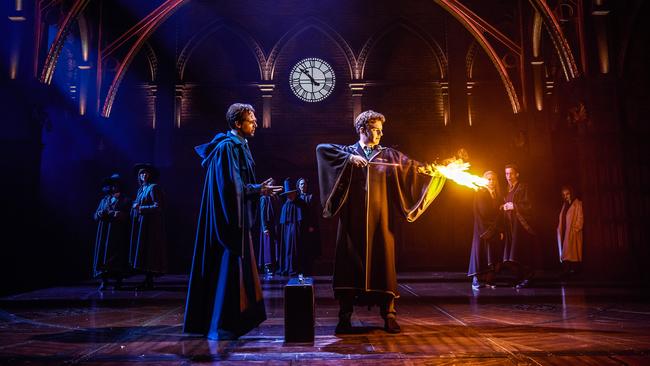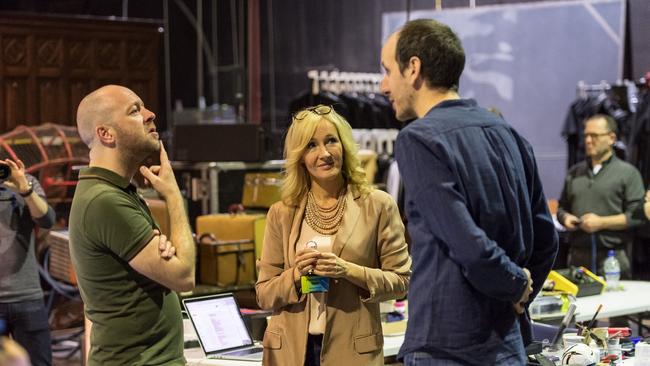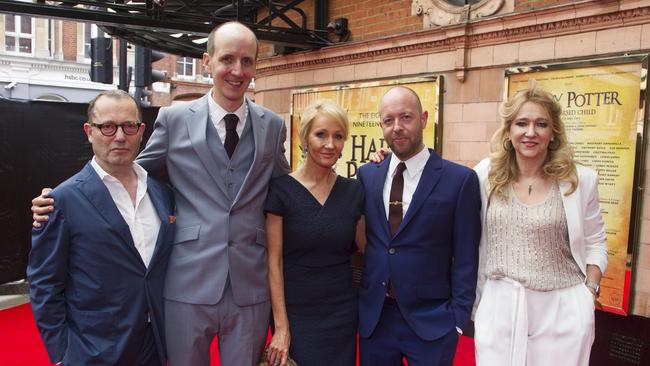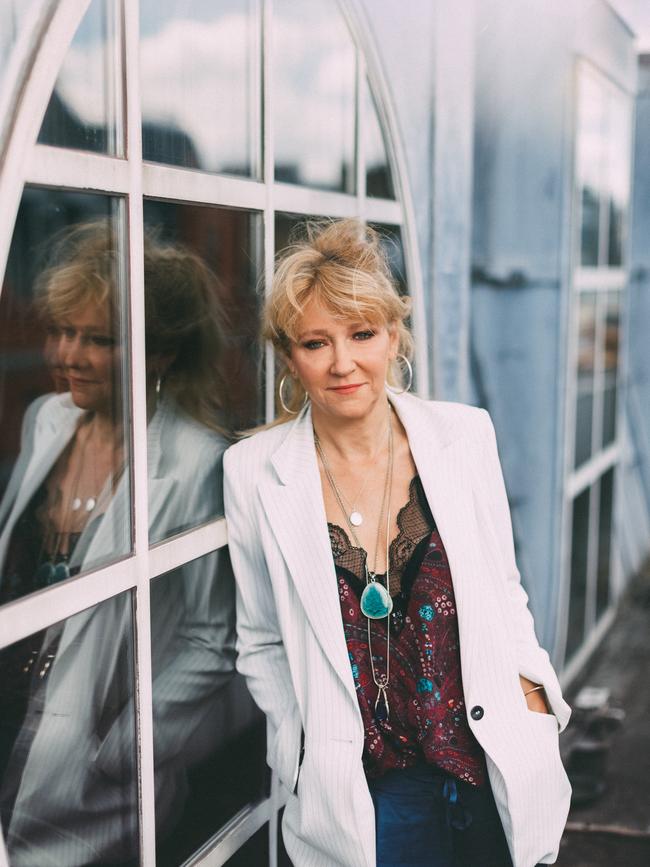Harry Potter and the Cursed Child
Hit play Harry Potter and the Cursed Child is getting a magical reboot. Review travels to Broadway to see the new cut bound for Melbourne.

Wizardry is complicated. This realisation crystallises on a recent trip to New York, where Review joins a group of die-hard fans to see the new take of the Broadway production of Harry Potter and the Cursed Child, ahead of the play’s opening in Melbourne.
Before we go to the Lyric Theatre we visit the Harry Potter flagship store, a three-storey trove of merchandise at 935 Broadway, where after stopping at the bar for a frothy cup of Butterbeer – a syrupy wizarding beverage that tastes like creaming soda – we are led upstairs to partake in a virtual reality experience.
With three other participants I don a headset and have my wrists and ankles strapped with sensors. Before we know it our avatars are being led through Hogwarts Castle by the little house-elf Dobby in a visceral adventure that culminates in a challenging task: to use the combined powers of our wands to destroy a fire-breathing dragon. Anyone with even a fleeting familiarity with JK Rowling’s seven Harry Potter books or the eight film adaptations will know this is no straightforward task. Countless lessons at Hogwarts have shown there is more than one way to wave a wand.
With a determined thrust I point at the monster, which roars flames in my face and throws around its giant tail. In frustration I shake the wand in front of me like a faulty TV-remote. How did Harry made it look so easy?
Then, the avatar of one of the other participants turns to look at me. In his real and serious human voice he brings me back to reality: “You need to raise the wand further above your head.”
At this moment the gaps in my Potter-knowledge are wildly regretted. The dragon crashes its way out the window.
W W W
Playwright Jack Thorne, 43, admits that, metaphorically speaking, he held his breath for the entire 3½-hour duration of Harry Potter and the Cursed Child when he saw the new version of his play — cut down from two separate performances totalling more than five hours — on stage for the first time last year. Such was the pressure of reimagining the hit two-part play, which has been seen by millions of people in London, New York, Tokyo, Melbourne and Toronto since it premiered at the West End’s Palace Theatre in 2016 and holds a record nine Laurence Olivier Awards (including best new play). Faced with the near-impossible task of slashing something so beloved — a move to make it more accessible to a wider audience — Thorne faced some uncomfortable decisions.
“Everyone had to be very brave,” Thorne tells Review over the phone, speaking from his home in the UK. “The play is one of the biggest things in all our lives and probably always will be. The process of changing that was scary because we didn’t want to break something that we believed in.”
Harry Potter and the Cursed Child is the eighth story in Rowling’s Potter cannon and picks up 19 years after the end of the seventh novel, Harry Potter and the Deathly Hallows. It is part of a proliferating Potter universe that also includes merchandise, the Fantastic Beasts film spin-offs (The Secrets of Dumbledore has just been released to lukewarm reviews) and an ardent fan fiction community.

Thorne outlined the story with Rowling and director John Tiffany before writing the script for the original two-part play. In doing so he became the first person other than Rowling to write a brand new Harry Potter story. Rowling and Thorne worked together most intensely on the two-parter where the famously hands-on author reviewed the drafts. Cutting down the play was more of a “technical job”, says Thorne, and involved “big passionate discussions” during pandemic lockdowns with producers Sonia Friedman and Colin Callender, choreographer Steven Hoggett and British director John Tiffany about what to chop.
“The intention was never to reinvent the story,” says Thorne, the in-demand writer behind TV series such as His Dark Materials and films including Enola Holmes. “It was always just to make the story faster but also find a way of dealing with the essence of it as much as we could. Losing young Harry” – Thorne refers to flashbacks in the two-parter – “was a huge discussion that went on for months but it was always sort of ‘OK, how do we make this more of itself?’ ”

Central to the play is the relationship between Harry (played by Gareth Reeves in the Australian production) and his son Albus Severus (Ben Walter). It’s a story Thorne shaped alongside his own journey to fatherhood. The playwright has spoken publicly about wife Rachel Mason’s conception of their son Elliott after seven rounds of IVF. Elliott was born two months before the play’s world premiere.
“When you are preparing to be a dad, you reflect on how you’ve learned how to be a human being and whether you’re going to be capable of being a dad.” says Thorne.
He pauses and adds: “I think you can feel that in the play. Harry has been everything everyone wanted him to be but (has also experienced) that trauma of being unloved, of not having people who cared for him, and then being thrust into a world where suddenly he is the most important person.
“The play is about how he managed to deal with that and then work out how to be a dad when his own childhood was a trainwreck.”
When Elliott was two months old Rowling wrote him a poem about growing up that remains above his bed. Since that time, Thorne has also done some growing as the boy’s dad. “Now I’m much more comfortable with what’s expected of me. None of us know how to do it at any point, we’re all making it up, aren’t we?”
W W W
We are almost through the first act of the reimagined production at the Lyric Theatre on Broadway when the actors encounter a problem. There is a thud as Moaning Myrtle, played by Michela Cannon, descends into the well. The curtain comes down and some patrons head to the foyer. But this isn’t intermission: Cannon has been injured. (Thankfully she is OK, albeit with some bruises). The scene reopens with an ebullient understudy resuming Myrtle’s position and the audience can only marvel at the professionalism and precision with which the show goes on.
“Live theatre hey?” Sonia Friedman muses over the phone, speaking some weeks later from the hall of her hotel in New York at about 5.30pm, or, as she jokes, the beginning of the day for theatre people. “You had the benefit of seeing a live show in action and all the excitement and risks and everything that you [don’t typically] have to deal with on a daily basis with a live piece of theatre.”
The producer is speaking amid what she calls the great “Covid pileup”. She is spinning plates on 19 different productions across the Atlantic and beyond that were interrupted by the pandemic and are now able to run. Harry Potter and the Cursed Child and Funny Girl are showing on Broadway. She is in pre-production for another Broadway show, The Piano Lesson, starring Samuel L. Jackson, and Tom Stoppard’s masterwork Leopoldstadt. She is also readying for a Sondheim revival of Merrily We Roll Along, starring none other than Daniel Radcliffe, at the off-Broadway New York Theatre Workshop.
Despite all the activity Friedman says “Broadway hasn’t fully settled yet” following the pandemic “but Harry Potter is absolutely doing extraordinary business. And it’s alongside the two or three other big hits here; Hamilton, The Lion King and Wicked. It’s going to be here for many, many years.”
Friedman is proud of Potter. She calls the play “my baby” – adopting a cutesy voice for “baby” – whose conception occurred around a decade ago in New York when she was shooting the breeze with producer Callender as they were sitting beneath a Potter film poster.
“We wondered about Albus, (Harry’s) middle son, who of course he sees off in the final chapter of Deathly Hallows,” she says. “We were figuring out what the emotional landscape would have been for the son and the father. How does an orphan become a parent?”
They decided to reach out to Rowling.
“We were very excited about explaining to her what journeys you can go on in theatre just using imagination and some lighting and minimal settings. And she loved the idea. She gave us the go-ahead to explore and go to the next stage.”
The production has been lauded for its incredible magic. For this casual Potter fan the Broadway production with its flawless illusions provoked the awe one relishes in musical theatre, yet retained the emotional nuance and intimacy of a play. (Indeed, Callender told Review in New York the production “is able to sit between a traditional play and a big musical … it’s original in that way”.)

When the two-parter premiered in Melbourne in 2019, The Australian’s Chris Boyd remarked: “The visual tricks and effects aren’t just ‘up there’ compared with cinematic CGI, they seem to carry more weight because they happen around us. In real life, as it were … There are scene-setting flashbacks, battling wizards, bolts of fire, flying furniture, shapeshifting and vanishing.”
Friedman says even though the two-part play was a big success, the producers always knew that in time they would need to make it a single event. “I don’t want to call it a global behemoth, but it’s a big piece,” she admits. “We knew that there would come a point that running a two-part show of this scale was just not going to be an economic viability for all territories all over the world.”
The epic posed a particular challenge for New York tourists, who typically make-up 70 per cent of Broadway ticket buyers and who were unable to see both plays if they touched down on a Thursday or Friday for a long weekend getaway.
The idea reached tipping point during the pandemic and the creative team used the time during lockdown to revise the production. The reimagined show opened on Broadway in December, just after the district fired up again following an 18-month pandemic shutdown.
Australian executive producer Michael Cassel says that while 326,500 people had seen the original production in Melbourne during its first year, a record for a stage play in Australia, it was clear when international borders shuttered in 2020 that a single event “would ensure that it’s really accessible to a lot more of the potential audience, both in terms of time and money”.
The two-part play wound up at the end of March, after which the cast went straight into rehearsals for the new version, wrestling with technical changes and an abridged script. The show’s Australian associate director, Naomi Edwards, admits it has been a “rewiring process” for the cast, many of whom have had the two-parter ingrained in their being.
“They’ll launch into something that was eight lines long and is now four lines long or what have you and say ‘Nope, I don’t say that anymore’,” she laughs, speaking from rehearsals in Melbourne.
“All of the soul and the heart and the meaning of the scene is still there. It’s just a lot more action-driven. We’re right in the middle of the process of the actors adjusting to that.”
Hoggett, the original movement director, and Tiffany, who directed the plays in London and New York, are in Melbourne to help the Australian company refine and choreograph the new sequences. Right now, says Edwards, who has a background in opera and theatre for children, they are pulling off the technical feat of creating an illusion around a rather threatening bookcase.
“It’s quite a detailed sequence in which the bookcase comes to life and becomes this menacing image,” she says. “It’s all driven by the actors themselves. It’s about co-ordinating the choreography with all of the sound effects … Everything is together on a pinhead.”
W W W
Only when Thorne saw the reactions of Friedman and the rest of the creative team to the reimagined production could he fully exhale, releasing the collective weight of expectation of all the Harry Potter fans – and future fans – who would go on to watch the Cursed Child.
Reflecting on the process, Friedman says the team was surprised at how adaptable the show was.
“There are more thrills and spills and more magic because it’s told over a shorter period of time,” Friedman says. “Those people who’ve seen both love them equally. They come away absolutely thrilled with this epic story. ”
Wizardry is complicated but feelings are simple.
Harry Potter and the Cursed Child opens at Melbourne’s Princess Theatre on May 19. Bridget Cormack travelled to New York courtesy of Michael Cassel Group.


To join the conversation, please log in. Don't have an account? Register
Join the conversation, you are commenting as Logout